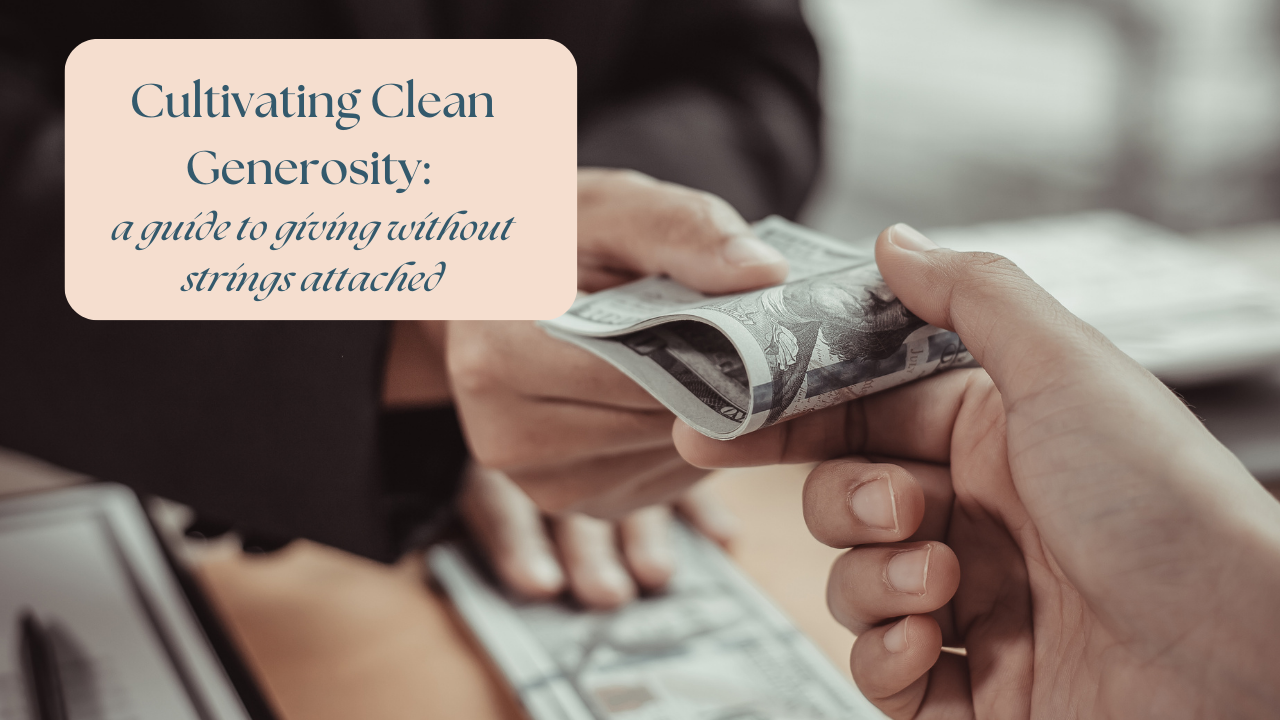Cultivating Clean Generosity: A Guide to Giving Without Strings Attached

Cultivating Clean Generosity: A Guide to Giving Without Strings Attached
In the season of gratitude and giving, it's crucial to navigate the fine line between generosity and unintentional relationship issues. The concept of clean generosity is about giving without imposing expectations or creating a manual on how the gift should be received. This delicate balance ensures that both the giver and the receiver experience the true essence of generosity without the burden of strings attached.
The Giving Manual: Lessons from Personal Experience
A poignant example of the giving manual surfaced in my own. I come from a farming family. When my grandfather passed in 1994 he left his 30-acre farm to his four children with strict instructions to never sell. Nine years later when my father passed, my sister and I inherited his quarter share. After a devastating flood, a change in market conditions and no family member able to farm the land, the farm became a burden, financially and emotionally. It took ten years before we could all release my grandfather’s words and sell the farm. The lesson learned was clear: a clean gift should not come with conditions, expectations, or ongoing monitoring.
Clean generosity is about giving without trying to control how the recipient uses the gift. It's recognizing that once the gift is given, it is no longer within the giver's realm of influence. The ability to release control and trust the receiver fosters a healthier and more fulfilling giving experience.
The Importance of Clear Intent
While clean generosity encourages freedom in how a gift is utilized, there are instances where specificity is crucial. For example, contributing to an education fund requires a clear understanding of the funds' intended use. Setting expectations upfront, especially in written form, ensures that everyone is on the same page. This clarity prevents misunderstandings and potential conflicts down the line.
When friends or family seek financial assistance, it's reasonable to want transparency about how the money will be spent. Establishing clear repayment expectations, if applicable, is a wise practice. However, the ideal scenario is giving without expecting repayment, provided the giver's financial stability allows for such generosity. This kind of giving is not only a gift to the receiver but also to the giver, fostering a sense of fulfillment and joy.
Giving Without Resentment
The key to giving without resentment lies in knowing one's financial boundaries. Before extending a financial gift, ensure that all personal needs are met, expenses are current, and consumer debt is minimal. Having at least three months of cash reserves acts as a safety net, allowing for a more secure and stress-free approach to giving.
If financial constraints limit your ability to give money, consider alternative ways to assist friends or family. Sharing a meal, offering childcare, or providing a temporary place to stay are invaluable forms of support that don't involve monetary transactions. Clean generosity is not solely about money; it encompasses the willingness to help in whatever way possible without creating a sense of indebtedness.
Bless and Release: Embracing Gratitude
When practicing clean generosity, it's essential to adopt a mindset of "bless and release." This means feeling gratitude for the ability to share and releasing any attachment to the outcome. Often, the strings attached to a gift are internal – feelings, expectations, or judgments. By acknowledging and releasing these internal strings, the act of giving becomes more authentic and enriching.
Consider a client whose concern for her daughter's finances during the pandemic led her to contemplate offering financial assistance. Through role-playing, she realized that such a conversation could create discomfort and strain on both sides. Clean generosity involves respecting the autonomy of adult children and understanding that, at times, the most meaningful support is given without direction. After our session, she decided to simply send a check with a note expressing gratitude and belief in her daughter’s ability to make wise choices during difficult times. The sent a sum she was very comfortable giving away without any expectations, without knowing how it would be spent, that she could send with love only. When her daughter received the loving note and unexpected check, she immediately called her mother from a place of gratitude. My client stayed in her power as the giver and she was grateful for the deeper relationship they experienced afterward once she saw her daughter as an independent woman that can benefit from a surprise gift rather than a young woman that needed rescuing, once again.
Conclusion
Cultivating clean generosity requires mindfulness, open communication, and a genuine desire to support without imposing conditions, whether it money or a set of heirloom china. As we navigate the season of giving, let us strive to give freely, without expecting anything in return. In doing so, we not only uplift others but also experience the true joy and fulfillment that comes from giving selflessly. Clean generosity is a gift that keeps on giving, fostering stronger relationships and a sense of interconnectedness within our personal relationships and communities.
If you would like to explore giving and receiving money with clean generosity, schedule a complimentary call with Liz Carroll, Financial Life Coach.

